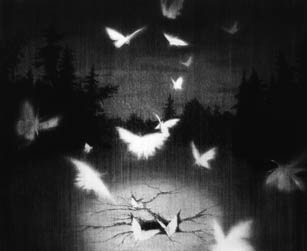Reece Jones: Assembly The Whiteness of the Whale Anna-Karin Jansson, Reece Jones, Nadia Hebson "Aside from those more obvious considerations touching Moby Dick, which could not but occasionally awaken in any mans soul some alarm, there was another thought, or rather vague, nameless horror concerning him, which at times by its intensity completely over powered all the rest, and yet so mystical and well nigh ineffable was it, that I almost despair of putting it in a comprehensive form. It was the whiteness of the whale that above all things appalled me. But how can I hope to explain myself here and yet in some dim, random way, explain myself I must, else all these chapters might be naught." (Chapter 42, The Whiteness of the Whale, Moby Dick, Herman Melville, 1851) Ending or Beginning? Whether the epitome of romantic writing or the first modern novel Moby Dick parades a flow of now familiar imagery and language to explore the nature of fear. In Chapter 42, The Whiteness of the Whale, Melville leads us to the very edge of visual understanding. Required at length to examine these associated icons, emblems and symbols (all requisite meanings heightened by their ghastly aspect of white) that we come to realise there exists a collective visual archive of the terrific. With his fulsome incantations: The majesty of justice in the ermine of the judge, the piteous sorrow of the pallid winding sheet, the wonderment and pale dread (of that white phantom) the spectral Goney, the wretched misadventure of the snow blind Lapp, the sleepless midnight passage atop the muffled rollings of a milky sea, Melville moves through received fact and symbolism charting tangible sources of terror to a far more foreign domain. Terrifying subtlety and unnatural contrast, the ill defined and unknowable begin to invoke a dragging dread. Transcendent horror manifest in a blank whiteness. This journey to the irrational does not attempt to picture in a simple way the roots of human anxiety. Rather it recognises that a blank mildness or reasonless natural force, especially when tinged with that spiritual countenance or non-colour, white, represents the very apogee of fear. As Melville mixes secular mythology with biblical truths, thwarting attempts to rationalise sentiments, a spectacular hybrid emerges; and its appearance in every regard intimates a loss of faith. Whilst Moby Dick's true horror is not so much a livid white whale as Captain Ahab's stymied reason, we are furnished with a rich miscellany of potent imagery that clutches at the heart of the Sublime. It is exactly because these conjured visions are beyond our full comprehension that they both terrify and awe. As the historical urgency of these philosophical and theological debates falls away we are left with nothing but the insistence of the arcane vision. The monochrome show "The Whiteness of the Whale" brings together 3 artists who recognise the insistence of the arcane. Whether their work seemingly explores a quiet epiphany, cataclysmic event, or quotidian activity all employ a highly developed, almost obsessive working process, the alchemical nature of which cannot be underestimated. These artists do not work towards what they know rather they fathom what they do not. Not necessarily light emerging from the darkness or even whiteness turning back to black, but mutability itself. Through the intoxication of making, mortality is both confounded and reaffirmed. The sublime experience a fleeting synapse and a slow drag. As Melville explores the symbolic potency of white he becomes entranced by the potential of language, similarly these artists are lost to their activity, mesmerised by the equivocal image. Exhibition: 10 February - 11 March 2007 Gallery hours: Fri-Sun 12 - 6 pm Transition Gallery Unit 25a Regent Studios 8 Andrews Road UK-London, E8 4QN Telephone +44 (0) 20 8533 7843 Email transition@huntergather.com www.transitiongallery.co.uk |
|
